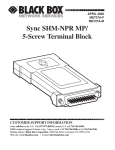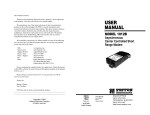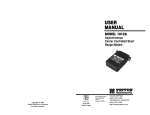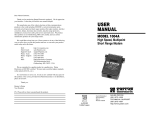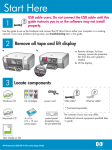Download SHM-NPR and SHM-NPR/RJ
Transcript
JUNE 2000 ME721A-M-R3 ME721A-F-R3 ME821A-M-R4 ME821A-F-R4 SHM-NPR and SHM-NPR/RJ DCE DTE -NPR SHM DCE DTE -NPR SHM CUSTOMER SUPPORT INFORMATION Order toll-free in the U.S. 24 hours, 7 A.M. Monday to midnight Friday: 877-877-BBOX FREE technical support, 24 hours a day, 7 days a week: Call 724-746-5500 or fax 724-746-0746 Mail order: Black Box Corporation, 1000 Park Drive, Lawrence, PA 15055-1018 Web site: www.blackbox.com • E-mail: [email protected] FCC/IC STATEMENTS FEDERAL COMMUNICATIONS COMMISSION AND INDUSTRY CANADA RADIO-FREQUENCY INTERFERENCE STATEMENTS This equipment generates, uses, and can radiate radio frequency energy and if not installed and used properly, that is, in strict accordance with the manufacturer’s instructions, may cause interference to radio communication. It has been tested and found to comply with the limits for a Class A computing device in accordance with the specifications in Subpart J of Part 15 of FCC rules, which are designed to provide reasonable protection against such interference when the equipment is operated in a commercial environment. Operation of this equipment in a residential area is likely to cause interference, in which case the user at his own expense will be required to take whatever measures may be necessary to correct the interference. Changes or modifications not expressly approved by the party responsible for compliance could void the user’s authority to operate the equipment. If this equipment is attached to a device which requires the use of shielded cables for compliance with FCC Part 15, then use of a filtered-pin connector might be required to maintain FCC compliance. This digital apparatus does not exceed the Class A limits for radio noise emission from digital apparatus set out in the Radio Interference Regulation of Industry Canada. Le présent appareil numérique n’émet pas de bruits radioélectriques dépassant les limites applicables aux appareils numériques de classe A prescrites dans le Règlement sur le brouillage radioélectrique publié par Industrie Canada. 1 SHM-NPR NORMAS OFICIALES MEXICANAS (NOM) ELECTRICAL SAFETY STATEMENT INSTRUCCIONES DE SEGURIDAD 1. Todas las instrucciones de seguridad y operación deberán ser leídas antes de que el aparato eléctrico sea operado. 2. Las instrucciones de seguridad y operación deberán ser guardadas para referencia futura. 3. Todas las advertencias en el aparato eléctrico y en sus instrucciones de operación deben ser respetadas. 4. Todas las instrucciones de operación y uso deben ser seguidas. 5. El aparato eléctrico no deberá ser usado cerca del agua—por ejemplo, cerca de la tina de baño, lavabo, sótano mojado o cerca de una alberca, etc. 6. El aparato eléctrico debe ser usado únicamente con carritos o pedestales que sean recomendados por el fabricante. 7. El parato eléctrico debe ser montado a la pared o al techo sólo como sea recomendado por el fabricante. 8. Servicio—El usuario no debe intentar dar servicio al equipo eléctrico más allá a lo descrito en las instrucciones de operación. Todo otro servicio deberá ser referido a personal de servicio calificado. 9. El aparato eléctrico debe ser situado de tal manera que su posición no interfiera su uso. La colocación del aparato eléctrico sobre una cama, sofá, alfombra o superficie similar puede bloquea la ventilación, no se debe colocar en libreros o gabinetes que impidan el flujo de aire por los orificios de ventilación. 2 NOM STATEMENT 10. El equipo eléctrico deber ser situado fuera del alcance de fuentes de calor como radiadores, registros de calor, estufas u otros aparatos (incluyendo amplificadores) que producen calor. 11. El aparato eléctrico deberá ser connectado a una fuente de poder sólo del tipo descrito en el instructivo de operación, o como se indique en el aparato. 12. Precaución debe ser tomada de tal manera que la tierra fisica y la polarización del equipo no sea eliminada. 13. Los cables de la fuente de poder deben ser guiados de tal manera que no sean pisados ni pellizcados por objetos colocados sobre o contra ellos, poniendo particular atención a los contactos y receptáculos donde salen del aparato. 14. El equipo eléctrico debe ser limpiado únicamente de acuerdo a las recomendaciones del fabricante. 15. En caso de existir, una antena externa deberá ser localizada lejos de las lineas de energia. 16. El cable de corriente deberá ser desconectado del cuando el equipo no sea usado por un largo periodo de tiempo. 17. Cuidado debe ser tomado de tal manera que objectos liquidos no sean derramados sobre la cubierta u orificios de ventilación. 18. Servicio por personal calificado deberá ser provisto cuando: A: El cable de poder o el contacto ha sido dañado; u B: Objectos han caído o líquido ha sido derramado dentro del aparato; o C: El aparato ha sido expuesto a la lluvia; o D: El aparato parece no operar normalmente o muestra un cambio en su desempeño; o E: El aparato ha sido tirado o su cubierta ha sido dañada. 3 SHM-NPR Contents Chapter Page 1. Specifications ............................................................................................. 5 2. Introduction ............................................................................................... 7 3. Configuration and Installation ................................................................. 9 3.1 Setting DTE or DCE ........................................................................... 9 3.2 The Installation Procedure ................................................................ 9 4. Troubleshooting ...................................................................................... 4.1 If You Have Difficulty ........................................................................ 4.2 Calling Black Box .............................................................................. 4.3 Shipping and Packaging ................................................................... 12 12 12 13 Appendix A: RS-232 Pinout ............................................................................ 14 Appendix B: Maximum Distances ................................................................. 15 4 CHAPTER 1: Specifications 1. Specifications Cable Required — 4-wire unloaded twisted pair with DC continuity (not included) Compliance — FCC Class A, IC Class/classe A Interfaces — Device side: Serial EIA RS-232-C, DTE or DCE (user-selectable, default DCE); Line side: Proprietary balanced 4-wire Protocol — Asynchronous Data Format — Transparent to data format Flow Control — Does not support hardware flow control (uses RS-232 control leads as power sources); transparent to software flow control Operation — 4-wire full duplex Data Rate — Up to 19,200 bps Maximum Distance— Up to 17 mi. (27.3 km) depending on cable gauge and data rate; see Appendix B User Controls — (1) Top-mounted DCE/DTE slide switch Indicators — None Connectors — ME721A-M, ME821A-M models: (1) Front-mounted DB25 male; ME721A-F, ME821A-F models: (1) Front-mounted DB25 female; ME721 models: (1) Internal 5-screw terminal block with strain relief; ME821 models: (1) Rear-mounted RJ-12 (“6-wire RJ-11”) female 5 SHM-NPR Leads Supported — DB25 (RS-232): See Appendix A Temperature Tolerance— 32 to 112˚F (0 to 50˚C) Humidity Tolerance— Up to 95% noncondensing Enclosure — High-impact plastic Power — ±12 VDC, 6.3 mA from RS-232 interface: From Pins 2, 4, 9, and/or 20 if the attached device is DTE; From Pins 3, 5, 6, 8, and/or 9 if the attached device is DCE CAUTION! When the device to which a SHM-NPR is attached is powered down, that SHM-NPR also loses power and can no longer send any signals to the remote SHMNPR. In this condition, the idled cable between the units becomes susceptible to receiving noise. If it does, and the device to which the remote SHM-NPR is attached is still powered ON, the remote SHMNPR might output spurious (“garbage”) data. Size — 0.8"H x 1.8"W x 2.2"D (1.9 x 4.4 x 5.6 cm) Weight — 2 oz. (57 g) 6 CHAPTER 2: Introduction 2. Introduction Built using the latest surface-mount technology, the SHM-NPR and SHM-NPR/RJ nonpowered short-haul modems attain high-quality performance in a low-profile package. The units operate full-duplex at data rates up to 19.2 Kbps over two twisted pairs (four wires). They require no AC power or batteries, but can support distances up to 17 miles (27.3 km; see Appendix B). The SHM-NPR and SHM-NPR/RJ have an external DCE/DTE switch, so you can connect them to any type of RS-232 device without opening their chassis. And you can terminate the line between pairs of these units in either of two ways: The SHMNPR models have a five-screw terminal block for hard-wired lines, and the SHMNPR/RJ models have modular RJ-12 (“6-wire RJ-11”) jacks. The specially designed strain relief on the ME721 models prevents thin twisted pairs from breaking or pulling loose. RS-232 device-side interface (DB25 male on ME721A-M units, DB25 female on ME721A-F units) DCE/DTE switch DCE DTE Balanced line-side interface (five-position terminal block) Figure 2-1. The SHM-NPR illustrated. 7 SHM-NPR Typical applications for these units are shown—not to scale, obviously—in Figures 2-2 and 2-3. In Figure 2-2, short-haul modems are being used to connect an async host computer to a faraway terminal. (The thing to remember about such applications is that if the computer and terminal are too widely separated, the host will time out before receiving it receives the terminal’s responses.) In Figure 2-3, short-haul modems are being used to enable a PC or server to send print jobs to a distant serial printer. Figure 2-2. Host-to-terminal application. Figure 2-3. PC-to-serial-printer application. 8 CHAPTER 3: Configuration and Installation 3. Configuration and Installation 3.1 Setting DTE or DCE You can configure your SHM-NPR or SHM-NPR/RJ as either a DTE or DCE device. Just slide the DCE/DTE switch on the top of the unit (shown in Figure 3-1) to “DCE” (if you are connecting the unit to a DTE such as a PC, terminal, serial printer, etc.) or “DTE” (if you are connecting the unit to a DCE such as a modem). You don’t need to open the unit’s cover to do this. DCE DTE Figure 3-1. The DCE/DTE switch. 3.2 The Installation Procedure On its device side, your SHM-NPR or SHM-NPR/RJ is designed to be plugged directly into one of the RS-232 serial ports on a terminal, computer, serial printer, modem, etc. For most applications, this eliminates the need for an RS-232-C data cable. (If you do need to use one for whatever reason, we recommend a shielded cable—our EDN25C, for example—that carries all of the pins from which the SHM-NPR draws power; just make sure to keep this cable as short as possible.) No power is required from a dedicated AC or DC source, because the unit is powered entirely by the attached device’s control and data signals. On its line side, your SHM-NPR or SHM-NPR/RJ has a proprietary balanced 4-wire twisted-pair communication-line interface. 9 SHM-NPR To install a pair of these units, take these steps: 1A. SHM-NPR (ME721 models) only: Making sure that they are not connected to any other device or any power source, gently pry the units open using a small screwdriver or similar tool wedged into one of the indentations on either side of the units’ cases. This will reveal a 5-screw terminal block mounted inside each unit. Run 4-wire twisted-pair cable (not included) from one block to the other as shown in Figure 3-2: one pair TX A to RX A and TX B to RX B, the other pair RX A to TX A and RX B to TX B, and the shield (if the cable is shielded) to the ground (middle) screw on one end of the cable only. When you are finished, lay the cable in the semicircle where it will emerge from the unit so that the strain-relief prongs can pierce the cable jacket, then close the unit back up. CAUTION! Under no circumstances should you attach the cable shield to the ground screws on both ends; this could cause damaging electrical “ground loops.” Neither should you ever connect these units to the public switched telephone system in any way. This could also severely damage your equipment. XMTXMT+ G RCV+ RCV- RCVRCV+ G XMT+ XMT- Figure 3-2. Wiring a pair of ME721 units. 10 CHAPTER 3: Configuration and Installation 1B. SHM-NPR/RJ (ME821 models) only: Get 4-wire twisted-pair cable and terminate it with RJ-11 or (especially if the cable is shielded) RJ-12 plugs, using the pin assignments shown in Figure 3-3 (for RJ-11 cable, substitute Pins 1, 2, 3, and 4 for Pins 2, 3, 4, and 5 respectively) and end-to-end wiring like that shown in Figure 3-2 on the previous page. Also, if the cable is shielded, attach the shield to Pin 1 or 6 on one end of the cable only. Plug the cable into the RJ-12 jacks on the units. CAUTION! Under no circumstances should you attach the cable shield to Pin 1 or 6 on both ends; this could cause damaging electrical “ground loops.” Neither should you ever connect these units to the public switched telephone system in any way. This could also severely damage your equipment. FEMALE PINS 123456 Unit—Pins 1 and 6 connected to frame ground MALE 2 (RCV-) 3 (XMT+) 4 (XMT-) 5 (RCV+) Cable—Pin 1 or 6 connected to shield on one end only; for end-to-end pinning, refer to Figure 3-2 on the previous page Figure 3-3. Wiring a cable for ME821 units. 2. Both models: Plug the units’ DB25 connectors into the RS-232 serial ports on the corresponding devices and tighten the mounting screws. That’s all there is to it. Assuming your units’ DCE/DTE switches are set properly, your SHM-NPR or SHM-NPR/RJ system should be ready for continuous operation. 11 SHM-NPR 4. Troubleshooting 4.1 If You Have Difficulty If your SHM-NPR or SHM-NPR/RJ system does not seem to be operating properly, here are a few things to check first: 1. Is the DCE/DTE switch set correctly on each of the short-haul modems? If the attached device is a DTE (computer, PC, terminal, printer, etc.), this switch should be set to DCE; if the attached device is a DCE (modem, etc.), this switch should be set to DTE. See also Section 3.1. 2. Check all external connections. Make sure they are firm and secure. 3. SHM-NPR (ME721) only: Detach the unit from the device and open its case. Make sure that none of the wires have come loose from the terminal block. 4. Use a cable tester to test the cable for continuity and pinning. If you still can’t determine what is causing the problem, call Black Box Technical Support as described in the next section. 4.2 Calling Black Box If you determine that your SHM-NPR or SHM-NPR/RJ is malfunctioning, do not attempt to alter or repair the unit. It contains no user-serviceable parts. Contact Black Box Technical Support at 724-746-5500. Before you do, make a record of the history of the problem. We will be able to provide more efficient and accurate assistance if you have a complete description, including: • the nature and duration of the problem. • when the problem occurs. • the components involved in the problem. • any particular application that, when used, appears to create the problem or make it worse. • the results of any testing you’ve already done. 12 CHAPTER 4: Troubleshooting 4.3 Shipping and Packaging If you need to transport or ship your SHM-NPR or SHM-NPR/RJ: • Package it carefully. We recommend that you use the original container. • If you are returning the unit, make sure you include everything your received with it. Before you ship the unit back to us for whatever reason, contact Black Box to get a Return Materials Authorization (RMA) number. 13 SHM-NPR Appendix A: RS-232 Pinout The table below shows how the RS-232-C ports of the SHM-NPR and SHM-NPR/RJ are pinned out. Please note that even though the control and voltage signals are listed, they are used only to help power the units; only the data signals are carried across the line. PIN 1 2 3 4 5 6 7 8 9 20 CIRC. AA BA BB CA CB CC AB CF — CD DESCRIPTION Protective Ground Transmitted Data Receive Data Request to Send Clear to Send Data Set Ready Signal Ground Data Carrier Detect +12 VDC Data Terminal Ready FUNCTION Ground Data Data Control Control Control Ground Control Voltage Control DIRECTION N/A To DCE From DCE To DCE From DCE From DCE N/A From DCE From attached device To DCE Note: Pins 1 & 7 are tied together inside the unit, as are Pins 4 & 5 and Pins 6, 8, & 20. 14 APPENDIX B: Maximum Distances Appendix B: Maximum Distances The table below shows how far pairs of SHM-NPRs and SHM-NPR/RJs can transmit data to each other at specified cable thicknesses and data rates. Please note that these measurements are for noiseless environments with not more than 20% of peak-to-peak distortion; figures for lines run through electrically noisy environments—near fluorescent lighting, elevators, generators, compressors, or motors, for example—will be dramatically lower. Data Rate (bps) Maximum Distance in Miles (km) for: Cable Gauge [AWG] (diameter): 19 (0.9 mm) 24 (0.5 mm) 26 (0.4 mm) 19,200 6.2 (9.9) 3.7 (5.9) 1.2 (1.9) 9,600 7.5 (12.0) 4.9 (7.8) 2.5 (4.0) 4,800 8.7 (13.9) 5.6 (9.0) 3.7 (5.9) 2,400 11.8 (18.9) 8.0 (12.8) 4.9 (7.8) 1,200 17.0 (27.2) 11.8 (18.9) 8.0 (12.8) 15 ©Copyright 2000. Black Box Corporation. All rights reserved. 1000 Park Drive • Lawrence, PA 15055-1018 • 724-746-5500 • Fax 724-746-0746

















